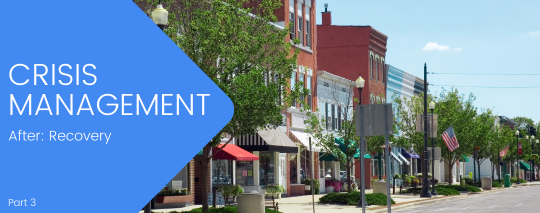If the last year has taught us anything, it’s that it is impossible to be 100% prepared for the unexpected. We’re thrown curve balls daily, but how can local leaders use them to identify their weaknesses, improve operations, and increase community resilience?
When it comes to emergencies, whether it be a cyberattack or a natural disaster, it’s important to be proactive. During these situations, citizens often look to their local leaders for direction and support. Local governments and other public services are faced with a responsibility not only to their employees but also to the communities they serve. As discussed in our series introduction, planning for before, during, and after an event occurs is crucial. In this post, we’re focusing on the before – how local governments and utility providers can prepare for the unknown.
Identify your vulnerabilities.
Small, seemingly harmless issues can quickly become crises if they aren’t mitigated and handled correctly. Weaknesses in your systems can put your office at risk. For example, take a look at your data security practices. Whether your office is hit with a cyberattack or faced with a natural disaster, such as a tornado or flood, it’s important to have solid security in place.
How you protect your data matters because it affects how quickly you can recover. Are your employees educated about the risks of attacks, such as phishing emails and ransomware? Do you have data backup and disaster recovery solutions in place? We explore tips on how to protect your community’s personal information and safeguard your data in the event of a cyberattack.
Performing regular audits of your operation’s hardware and software can further help you weed out vulnerabilities. In the case of natural disasters, ensure your emergency plans are set and you partner with local resources, such as fire and police departments, so they know where and when their services are needed in the event of a crisis. Also, assess your community’s preparedness. Ensure they have the training, education, and resources they need to prepare in advance.
Develop a crisis management plan.
Long-term disaster preparedness is a must for local governments, but many do not have a plan that encompasses both pre-disaster resilience and long-term recovery. In natural disaster cases, a short-term emergency response strategy may not be enough if the effects are detrimental to your organization or your community.
The obvious challenge to creating a plan is that crises often happen unexpectedly without much warning, and when they do, there are many scenarios to consider when preparing. The best way to start is to have a broad plan that can adapt to various scenarios. Start in layers and build as you go. As the plan is more defined, you can evaluate its strength based on different possibilities and modify it as needed. Of course, doing so can consume a lot of time, money, and resources, but it’s worth it in the long run to protect your operation and the community you serve.
Also, remember you should not prepare alone. Find allies in your community and inside your operation that can help. Coordinate with them and create a shared vision. In addition, there are many resources online to help local governments and services develop emergency management plans for defense against natural disasters and security attacks, such as:
- ICMA’s Emergency & Disasters Topics
- Multi-State Information Sharing & Analysis Center® (MS-ISAC)
- Federal Emergency Management Agency (FEMA)
Create a strong crisis communication strategy.
These days, news spreads fast. Anyone can share their observations and opinions on social media in an instant. That’s why developing a solid crisis communication plan is one of the most important steps. When a crisis occurs, it’s critical to take control of the narrative and be transparent and honest with your community’s safety as top priority.
We’ll talk more about communication when we explore crisis response in part 2 of this series.





